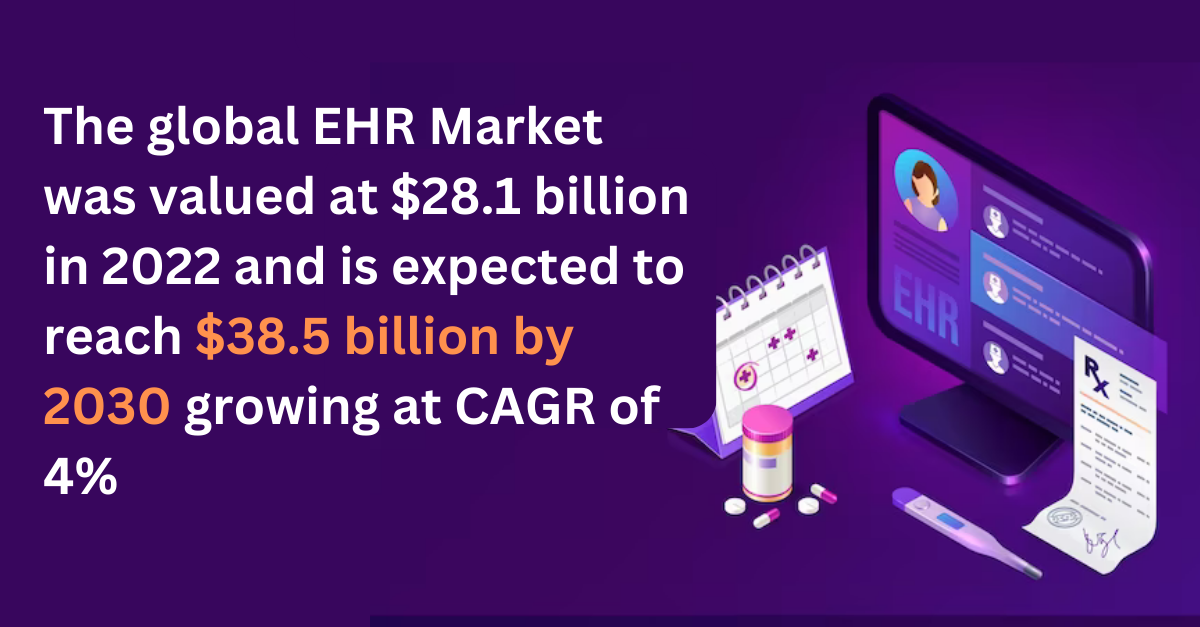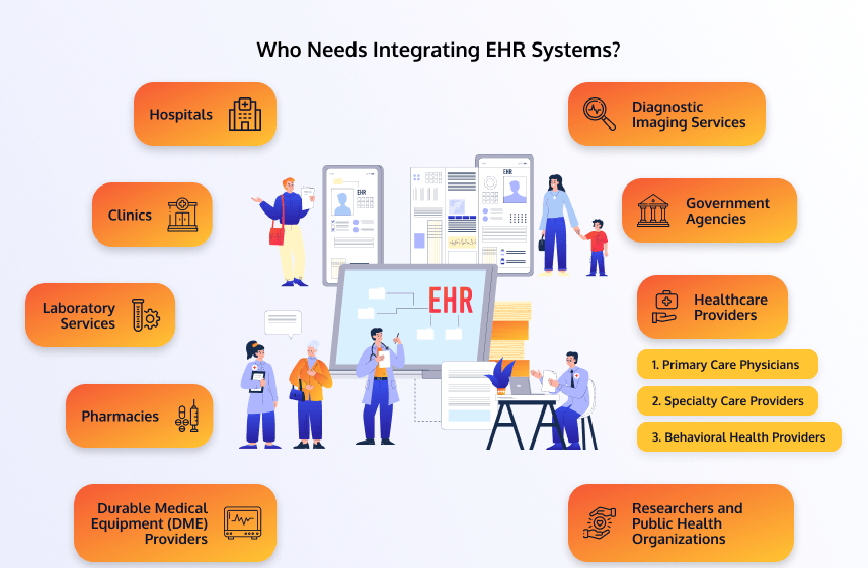
EHR Integration Guide
Data integration plays a crucial and intricate role in achieving success in the healthcare industry, regardless of your role. Whether your product or service focuses on accelerating revenue cycles, facilitating virtual doctor-patient connections, or finding solutions to major health challenges, the seamless sharing and utilization of health data with other systems are paramount. Without effective data integration capabilities, your progress and impact will be severely limited.

Advantages of EHR integration
EHR integration plays a crucial role in achieving success and improving patient outcomes in healthcare. Here are some key reasons why EHR integration is essential:
- Comprehensive view of patient data from multiple sources
- Streamlined workflows and reduced administrative tasks
- Improved care coordination and communication among healthcare providers
- Decision support tools for accurate diagnoses and treatment choices
- Enhanced continuity of care across different healthcare settings
- Valuable data for analytics and population health management
- Reduction in medical errors and adverse events
- Improved efficiency and time savings for healthcare professionals
- Increased patient engagement and access to personal health information
- Facilitation of interoperability and health data exchange between systems

Challenges in EHR Integration
Healthcare data integration is a complex process due to several factors.
-
Various Data Formats
Firstly, there is a wide range of evolving healthcare data standards, leading to variations in system deployments.
-
Health Sytems complexity
Furthermore, the existence of hundreds of electronic health record (EHR) and practice management systems, sometimes within a single health system, adds to the complexity.
High volume of data
The volume of data being generated and processed in these systems is also increasing rapidly, with the healthcare industry responsible for approximately 30% of global data generation. This exponential growth necessitates the expansion of integration efforts beyond the EHR.
EHR customization
EHR systems often need customization to meet the specific needs of healthcare organizations. Balancing customization requirements with system limitations and future scalability can be a challenge.
Regulations
EHR integration introduces additional considerations for data security and patient privacy. Safeguarding sensitive patient information and ensuring compliance with relevant regulations, such as ONC, CMS and HIPAA, is a critical challenge.
To navigate these complexities and foster growth, developers of digital health solutions require a well-thought-out data integration strategy that enables seamless health data exchange with various stakeholders such as hospitals, payers, and public health agencies. While efficient integration can accelerate time to market, it often necessitates specialized expertise beyond the core competencies of development teams.
What are consequences of EHR Integration failure?
EHR integration plays a crucial role in healthcare as it ensures smooth workflows and enhances patient outcomes. Integration failure can disrupt workflows, leading to inefficiencies, delays, and potential errors in care delivery. It is essential to prioritize EHR integration to enhance workflow efficiency and ultimately improve patient outcomes. Some of the consequences include:
-
Patient safety risk
Integration failures can lead to errors in health data exchange, resulting in incorrect or incomplete patient information. Further, a 2016 study by The Leapfrog Group, a patient-safety watchdog group discovered that the medication-ordering functionality of hospital EHRs failed to flag potentially harmful drug orders in 39 percent of cases in a test simulation, 13 percent of those cases, the mistake could have been fatal
-
High clinician burnout
Integration failures can cause frustration and dissatisfaction among healthcare providers who rely on seamless access to patient information. Approximately 40% of total clinician stress can be attributed to poor clinical process design and clinical culture, often negatively impacted by EHR systems. In a study, 71% of clinicians reported that their EHR contributed to burnout.
-
Data Inconsistencies
Integration failures can result in data inconsistencies or discrepancies between systems, leading to inaccurate and unreliable information. This can hinder effective communication and collaboration among healthcare providers.
-
Declines in clinical effectiveness
Failed integrations can disrupt healthcare workflows, causing delays in accessing patient information, coordinating care, and making timely decisions. This can impact operational efficiency and patient satisfaction. Stanford survey 49% of clinicians surveyed indicated that their EHR reduced their clinical effectiveness, which can hinder the delivery of quality patient care.
-
EHR-related financial problems
EHR integration failures can result in additional costs for troubleshooting, fixing errors, and re-implementing integration solutions. Survey data from the MPI Group and Medical Economics indicate 65% of respondents who recently implemented new EHR software say their EHR systems resulted in financial losses for the practice.
-
Missed Opportunities for Data-driven Insights
Failed integrations can hinder the ability to aggregate and analyze data from different sources, limiting the potential for data-driven insights, research, and quality improvement initiatives.
-
Legal and Compliance Issues
Integration failures may lead to non-compliance with data privacy and security regulations, such as HIPAA. This can expose healthcare organizations to legal liabilities, financial penalties, and damage to their reputation.
Key considerations for successful EHR Integration
Making integration possible can be achieved through various approaches. A crucial initial step is to comprehend the data that needs to be accessed and determine the appropriate location for its presentation, aligning with your business needs. Below are the considerations in EHR integrations:
-
System Compatibility
Before embarking on an EHR integration project, it is essential to assess the compatibility of the chosen EHR system with existing healthcare infrastructure. The integration should seamlessly work with other clinical systems, such as laboratory information systems, imaging systems, and medical devices. Compatibility ensures a cohesive and efficient healthcare ecosystem. For instance, let's consider the integration of a telemedicine solution with hospital EHRs. It becomes essential to grasp the HL7 standard to interpret where the necessary data is available within the EHR's interface messages. Additionally, understanding the workflows in which your solution operates and how they interact with the EHR is vital. These workflows can influence the interfaces and standards utilized for data reading and writing.
-
Data Security and Privacy
As electronic systems handle sensitive patient information, ensuring robust security measures is paramount. Healthcare organizations must implement industry-standard security protocols and encryption mechanisms to protect patient data from unauthorized access. Compliance with privacy regulations, such as the Health Insurance Portability and Accountability Act (HIPAA) in the United States or the General Data Protection Regulation (GDPR) in the European Union, is vital for safeguarding patient privacy.
-
Customization and Workflow Alignment
Each healthcare organization operates with its unique set of workflows and processes. Therefore, it is essential to evaluate the EHR system's ability to be customized and tailored to match specific workflow requirements. Seamless integration of EHR functionalities into existing clinical processes ensures minimal disruption and maximum adoption by healthcare professionals.
-
Staff Training and Change Management
EHR integration involves a significant shift in how healthcare providers and staff interact with patient data. To ensure a smooth transition, comprehensive training programs should be designed to educate healthcare professionals about the new EHR system. Additionally, developing effective change management strategies is crucial to address resistance and promote user adoption. Involving staff members in the decision-making process and continuously addressing their concerns helps create a positive environment for EHR integration.
When it comes to digital health data exchange, there is no universal solution that fits all scenarios. Each product, solution, and concept have distinct requirements that need to be considered. Below are eight key steps that our teams have identified as crucial for successful integration, with the timeline varying based on the organization.
Steps for every Integration
-
Planning & Building Integration Layer
Assess your product or application to ensure it has features that allow for health data exchange. If you don't already have an integration layer, you will need to build it or find a partner who can build it for you. This layer should be able to handle integration with different systems now and in the future.
-
Planning & Paperwork
Initiate the necessary steps, including preparing contracts, signing business associate agreements, and holding kick-off meetings.
-
Gathering Requirements
Collect the data necessities, such as sample HL7 messages, sample JSON, associated data dictionaries, and the vendor's API documentation.
-
Defining Infrastructure and Secure Connectivity
Make decisions regarding infrastructure deployment and establish secure connectivity, including considerations for VPN access, to serve as a foundation for interface configuration.
-
Configuring and Coding Each Interface
Set up the endpoints and interface mappings for each organization and vendor, ensuring seamless communication.
-
Testing
Send sample messages for review and acknowledgment by both inbound and outbound users. Identify and resolve any issues prior to completing testing.
-
Going Live
Enable all channels by migrating to the production environment. Open data feeds and allow the vendor to populate the system. Integrate the data feed into the EHR or another inbound interface.
-
Ongoing Support
Determine and implement support and alert plans to ensure continuous assistance and maintenance for the integrated system.
Reliable Technology Partner you can count on
Health IT systems are constantly evolving, with regular updates, configuration changes, and advancements in security protocols. It is crucial to have dedicated and experienced professionals who can keep up with these changes and address any issues that may arise. Attempting to manage everything on your own is often not the best choice for Heath IT application developers.
With over 20 years of experience in the US Healthcare IT services industry, our company specializes in providing integration services using industry-standard data formats such as HL7-FHIR (Fast Healthcare Interoperability Resources) and interface engines. Leveraging our extensive expertise, we provide high-level assistance tailored to meet your specific needs, helping you achieve substantial growth and success.





